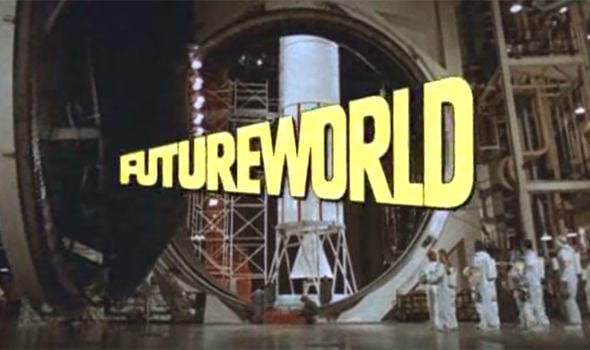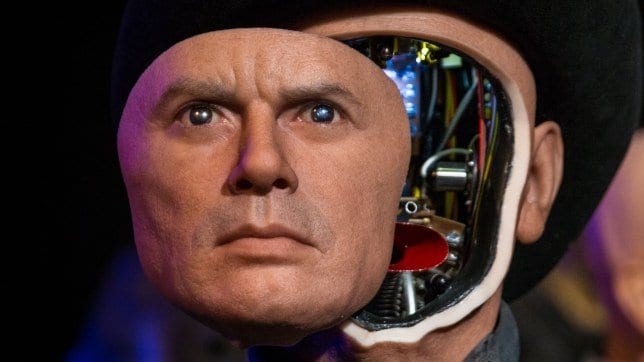The source material for the hit HBO show Westworld is a 1973 film with the same name. The television show has created two fantastic and brutal seasons, with a third season on its way. The original Westworld, and its 1976 sequel Futureworld, took a much simpler approach to the concepts of conflict, humanism, and artificial intelligence.
Westworld was written and directed by Michael Crichton – the guy who eventually went on to write Twister, Jurassic Park, Congo, and Timeline, as well as the TV juggernaut E.R. This film couldn’t help but show it was under the helm of a novice director. Having only directed one (made-for-TV) movie, moving to feature length films was perhaps a step that Crichton wasn’t ready for. There are issues with pacing and tons of awkward silences; the whole viewing experience feels like a clunky collection of several short films pieced together. It still has its share of great ideas and moments though, showing the potential for greatness that Crichton would eventually achieve in the world of fiction.
The story of Westworld starts out pretty simply – two guys are coming to hang out and have the trip of a lifetime at the steep price of $1,000 a day (1970’s money). John, the buddy who is paying for this trip to help his pal Peter get over a divorce, is pretty positive this is going to be awesome (spoiler alert: it’s not his first trip). “Delos” is the name of the park, and it has three separate areas to enjoy: there’s a medieval park, Ancient Rome, and obviously a “western frontier” setting, which our protagonists have elected to visit. While they do spend some time showing the other worlds, they don’t really give you time to meet the other humans enjoying the park, and they also don’t even bother to introduce you to any of the Delos staff. There isn’t a lot of the story dedicated to the humanity of the people involved, or to filling out the backstory of the robots. The odd part about this lack of storytelling is that the movie isn’t particularly long, coming in under 90 minutes. There was some room to develop the script if they wanted to, but Crichton choses to leave the peripherals pretty bare.
The character of John feels very odd in the film; he acts bored and uninterested in living the Wild West experience, with the exception of visiting with the robot hookers. This ultimately begs the question of why come to Westworld at all? The actual origin of the “virus” isn’t really explained anywhere, but malfunctions pile up and begin to create anomalies in the robots. When viewed through a 1970’s lens, not much more explanation would be required, but from today’s perspective the whole thing flows fairly clumsily. This movie is one of the earliest to reference a computer virus though, if that helps add perspective.
As things turn in the movie and “Gunslinger” turns on John and Peter, the viewer already know the robots are killing people (because of the earlier scene in Medieval land where the Black Knight refuses to lose and stabs a guy with his sword.) This mixed-up storytelling takes away a lot of surprise and suspense, ruining what would be a great twist opportunity.
From here the movie devolves into a kind of prototypical Terminator, with Gunslinger chasing Peter through all three parks and killing any humans he crosses paths with. There is a great visual effect in the climatic chase scene where Peter throws acid at Gunslinger and appears to melt his face. They achieved this through the use of crushed Alka-Seltzer in a heavy oil makeup on Brynner’s face; when the character of Peter throws liquid at Brynner, his skin actually bubbles and appears to melt.
The film did very well at the time in the box office and has met the test of time with a current Rotten Tomatoes score of 86%. This is rather impressive for a movie that even according to Michael Crichton had the audience laughing at the wrong times. The movie doesn’t stand up to the two successful seasons of the HBO show, but it remains very watchable for its own reasons.
Futureworld 1976

The film had a sequel in 1976 – Futureworld. A few years have passed, and over $1.5 billion dollars has been spent rebuilding and improving all the elements of the park. Delos has added a fourth area – Spaworld – and replaced Westworld with a “Futureworld,” set on a space station. The protagonists this time around are actually undercover reporters, friends of a colleague who was murdered while investigating the Delos corporation. As one would expect, thing go badly. It is revealed that the robots have taken over, and are trying to replace people with clones programmed to obey Delos. This is an odd twist on the concept, and probably a more frightening idea than the robots going crazy. If the rich and powerful of the world who take a Delos vacation were replaced by loyal clones, they could then bring other rich and powerful elites to experience the Delos experience, establishing a powerful illuminati type organization. It wouldn’t take long before political power and favor was seized by the robots, and very soon the world would be under control of artificial overlords and not even know it. That is a terrifying concept.
Even though Futureworld did struggle to capture the spark that Westworld did during its theatrical run, the franchise did survive long enough to spawn a few episodes of an original television series titled Beyond Westworld. The legacy of this franchise is more impressive than the films themselves at this point, when looking at what the films accomplished. Spawning two television shows and two movies, with a freshman director and a meager budget, the film made back ten times the budget. One of the main themes of science fiction is the battle between robot and man; another has been about control of humanity and ego. The allure and appeal of losing yourself in a world devoid of consequence and morality because the victims aren’t human is a dangerous proposition.
The questions raised by a world without repercussions are dangerous and intoxicating. What if we lived in a world where you just shot people with no consequences? What if we lived in the Wild West, where whiskey drinking, gambling, robbing stage coaches and partaking of ladies of the night wasn’t just accepted but was the social norm? Are we only good people because we have to be, or because we want to be? This becomes the true moral dilemma of the movie. Is it fun to do crime and commit murder, or is it just base curiosity? This appeal and the allure is painted well in the film, but perhaps even better in the television series, where they take the time to introduce viewers to characters and people involved in the story. In the television series that they make better choices plot wise too, like cutting power in a control room in a way that doesn’t prevent the technicians from being able to get out or breathe. Overall the film is good but if you’re seeing one for the very first time, you’re better off catching the show on HBO.

